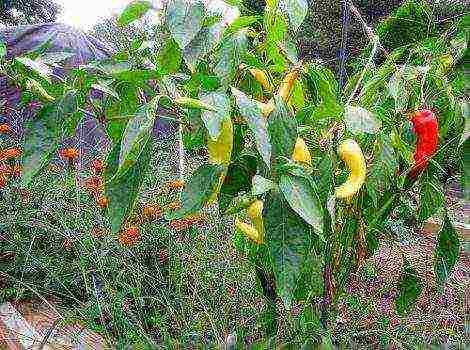Content
- 1 Purslane features
- 2 How to propagate a plant
- 3 How to care for a garden purslane
- 4 Problems with growing purslane
- 5 Growing on a windowsill: can a purslane grow at home
- 6 Features of growing in balcony pots and in the open field
- 7 Airy marshmallows and other varieties of purslane
- 8 How to propagate purslane
- 8.1 Reproduction of terry varieties by cuttings
- 8.2 Sowing seeds for seedlings
- 8.3 Sowing directly into the ground
- 8.4 Planting seedlings in the ground
- 8.5 Where and in what soil is it better to plant a flower
- 8.6 Outdoor purslane care
- 8.7 How to collect seeds
- 8.8 How can you save purslane in the winter
- 8.9 How to grow purslane in winter
- 8.10 If the purslane does not bloom
- 9 Room purslane (on windows and balconies)
- 10 Florist reviews
After looking through different photos of purslane, it is sometimes difficult to guess that we see the same plant. These are bright flowers with fleshy needles, and grass that is weeded out from the beds. Purslane is a healthy and beautiful crop that can be grown both outdoors and at home. In addition, this plant is very unpretentious, so even novice growers can handle planting and care.
Purslane features
On the bags with purslane seeds it is written: annual. But it is not so. In our climate with harsh winters, the plant lives in the open field for one season - from spring to autumn. But in the southern latitudes, purslane is a perennial.
Purslane does not tolerate winter, therefore, in a temperate climate, it is grown as an annual
Herbaceous plant with beautiful flowers - native to the subtropics of South and Central America. Orchard purslane, or vegetable purslane, which we consider to be a weed, is called a cosmopolitan. It grows on all continents.
In many countries, for example, in France, India or the Caucasus, this plant is eaten. Purslane is rich in vitamins C, K, E, PP, B1 and B2, carotene and microelements. In cooking, young shoots and leaves are used, from which salads, stews, and marinades are prepared.
Russian gardeners pull out purslane from their beds, but in many countries it is a valuable vitamin plant.
In Russia, the edible species is rarely cultivated. But decorative purslane is widespread. It is often planted in flower beds, alpine hills, rockeries (a type of rocky garden) and rabatkas (rectangular beds along paths), they are used to decorate balconies and terraces. This plant takes root well on any, even the most scanty soils, can tolerate drought, does not require weeding and feeding. Its creeping stems grow, forming a dense "carpet" of green villi-leaves with a pattern of bright inflorescences. The bud opens only for a day, so the multi-colored ornament is always different.
Purslane carpet changes color every day
Purslane blooms all summer - from mid-June to September or October, until frost begins. The only requirement is abundant lighting. Purslane is a child of the sun, its flowers do not open in cloudy weather. Although now varieties have been bred that are tolerant of shading.
Choosing between a perennial and an annual flower
Experts have developed many varieties for open ground, with simple and double flowers of the most whimsical color. However, attempts to grow them at home are rarely successful. The maximum that turns out: keep the varietal plant at home until next year, and after frost, plant it again in the ground or cut a bush.
But not so long ago, hybrid varieties of purslane appeared, which are successfully cultivated both in indoor floriculture and in gardening. These hybrids have simple inflorescences. But in the cold season they grow on the windowsill, and in the summer they bloom in the same pot on the balcony or in the garden.
Purslane can be brought home in the fall and stored until next spring.
The advantage of perennial purslane is its longevity in one pot, and the disadvantage is modest inflorescences and less lush flowering, compared to annual garden varieties.
Garden purslane is not only a riot of colors and long flowering, but also an annual sowing
And garden varieties delight in the richness of colors, the size and shape of flowers, but they must be grown from seeds or cuttings every spring anew, and then planted in the ground. True, there is a way to trouble-free growing purslane. Plant a flower bed once, and then let the flower scatter the seeds on its own and do not dig up this place. Purslane will rise on its own, but this option is acceptable in relatively warm regions. The colder the climate, the longer the seeds of a heat-loving plant do not germinate. This means that the flowers will appear by the middle or even by the end of summer.
Purslane embodies the fantasies of flower growers and grows beautifully in one place, scattering on its own
Ampelny, large-flowered, garden and other varieties of purslane
According to some classifications, the genus of purslane comprises almost 200 varieties, according to others - about 100. But the overwhelming majority of them never became cultivated plants. In decorative floriculture, large-flowered purslane and many varieties based on it are common.
- Garden purslane, or vegetable, is an edible plant, but Russian gardeners pull it out like a weed. Thick reddish stems grow up to 30 cm. They spread along the ground. Leaves are oval, juicy. Flowers are yellow, small. Young leaves and shoots are eaten. The taste of purslane is similar to spinach with a sorrel flavor.
- Ampelny purslane is a perennial hybrid species suitable for growing at home and in the open field. The plant has fleshy stems that branch well, thick oval-shaped leaves. The flowers are simple, in different shades of white, red, yellow, purple. Ampel purslane is planted in hanging baskets and tall flowerpots so that the shoots droop beautifully.
- Large-flowered purslane is a decorative species that is very popular all over the world. In Russia, it is grown as an annual plant. Blooms from June until frost. It is a ground cover plant with creeping shoots. They are covered with a thick brush with needle-like thick leaves. Large (5-7 cm) flowers, double or simple, are located at the ends of the stems, one or three. The flowers of this particular type of purslane are compared to a rose or a peony. In most varieties, the buds close at night and do not bloom on cloudy days.
Double flowers bloom in cloudy weather
Terry varieties are more relaxed about partial shade and bloom well even in the absence of a bright sun.
Dozens of varieties have been created on the basis of large-flowered purslane. The most popular ones are:
- Royal (with simple and very large flowers of various colors);
- Airy marshmallows (with short stems and large double flowers);
- White-flowered (similar to Airy marshmallows, but with snow-white inflorescences);
- Princely (with white, orange or bright scarlet inflorescences with corrugated petals);
- Splendens (with spectacular purple-purple double flowers);
- Illusion (with large semi-double flowers of a cherry or pink hue);
- Extravaganza (with contrasting strokes and dots on flower petals);
- Amber Coast (with lush yellow-orange colors).
Photo gallery: what different varieties look like
A few words about the garden purslane
Purslane vegetable, which many gardeners destroy, considering a weed, is not only useful, it is used to treat many diseases. Stems, infused with alcohol, help with arthritis, heal ulcers. Decoctions and infusions are used for insomnia, eye diseases, dysentery and diabetes mellitus.
Vegetable purslane greens are very useful and pleasant to the taste.
Vitamin greens of purslane are low in calories, so it is an excellent component of dietary nutrition. Young shoots with leaves are fried, stewed and pickled. In order to retain all the benefits of purslane, eat it fresh.
Garden purslane is an early culture. It is planted directly in the ground from late May to mid-June. Care consists in timely watering. With a lack of moisture, the leaves become coarser. The first harvest of young greenery is harvested within 3-4 weeks after sowing.
Video: acquaintance with the unpretentious purslane
How to propagate a plant
Purslane is propagated by seeds and cuttings. Freshly harvested seeds will not germinate, they need to lie down for about six months. And they retain their germination capacity for about 3 years. You can sow purslane directly into the ground when the average daily temperature is at least 20 ° C. In addition, seedlings can be grown.
Seedling method
- Sow seeds for seedlings at the end of March or April (the warmer the climate, the earlier, but you should not rush - the seedlings may outgrow).
- Prepare low containers (about 7 cm high), preferably with a transparent lid, and make drainage holes in them. Fill containers. Lay a small drainage layer (perlite, fine expanded clay, vermiculite) and a light substrate (sand, garden soil, charcoal chips). Ready-made soil for seedlings is not suitable, it contains peat, in which purslane does not grow well.
For purslane seedlings, low containers and light soil without peat are needed
- Compact the soil and water.
- Mix the purslane seeds with sand and spread over the surface.
- Cover the container with a lid, glass or foil.
- Place in a warm (average daily temperature not lower than 25 ° C) and well-lit place (southern windowsill, on the other hand, there must be a backlight).
- Ventilate the greenhouse regularly and moisten the substrate if it is dry. After 5-10 days, the seeds will sprout.
In warmth and in good light, purslane sprouts appear after 5-10 days
- Remove the shelter after germination.
- Keep warm (temperatures below 20 ° C can be detrimental to seedlings) and provide bright light.
- Moisten carefully, excess moisture leads to black leg disease. Better to water through a sump.
Purslane seedlings must be watered carefully
- When the shoots have 2-3 true leaves, thin them out, leaving the strongest ones.
Purslane crops must be thinned out to give room for development to the remaining seedlings
- Unpack them into separate containers. At the same time, be careful with the spine, transfer the sprout with a lump of earth. Deepen to the cotyledonous leaves.
When diving, carefully handle the spine, deepen the sprouts to the lower leaves
- Gradually accustom the seedlings to the outdoors, exposing them to fresh air during the day (at first for 20 minutes, gradually increasing the time).
Temper seedlings so that there is no stress from transplanting to the street
- After the threat of frost has passed (at the end of May-first half of June), and the average daily temperature is 20-22 ° C, transplant the seedlings into open ground.
For the seedlings of purslane to take root, you need warmth, sun and poor soil.
- For the purslane, choose a warm, well-lit area with poor soil.
- Place the sprouts at a distance of 10-15 cm, deepen the seedlings to the first leaf.
Video: sowing terry purslane for seedlings
How to plant seeds outdoors
Purslane is sown directly into the ground in late May and early June. We must wait until the soil warms up to 20–25оС. Purslane sprouts can die if it gets cold even slightly, not to mention freezing.
Sow a purslane where it will grow constantly
How to sow seeds: a step-by-step process
- Make a bed for purslane in a sunny area, protected from the wind. Ideally, it will be a slight elevation.
- Add sand to too nutritious soil.
- Moisten the soil, spread the purslane seeds on it, sprinkle it with sand on top.
- Cover the bed with plastic wrap or glass.
- In the afternoon, when it gets warm, open the garden bed for 2-3 hours to ventilate.
- Moisten crops as needed by spraying from a sprayer.
- When shoots appear and the temperature is at least 24–26 ° C, remove the film.
- Seedlings that have grown to 2-3 cm, thin out and transplant to a permanent place, scheme - 10:15.
- Water at the root when the top layer dries.
Landing before winter
Sowing purslane before winter is only worth in the southern regions. The seeds of a heat-loving plant will not start growing until the soil warms up to 20–25оС. So in mid-latitudes there is no point in podzimny sowing, early flowering will still not work.
It is better to sow purslane before winter in regions with a warm climate.
- Choose a heated and illuminated area for a purslane flower bed, it will be good if it is a hill.
- Remove the weeds and prepare the bed.
- Sow twice as many seeds as during spring sowing. Mix purslane seeds with sand.
- Spread the mixture over the soil, sprinkle lightly.
- In the spring, make sure that the area does not dry out at all after the snow melts.
- You can cover crops with foil to keep warm.
- After seed germination, care for normal seedlings.
Propagation by cuttings
Purslane can cuttings all summer to renew plantings. Also, this method will help speed up the appearance of the first flowers.
- In the fall, transplant the purslane bush into a pot and transfer it home.
The purslane bush can be left at home for the winter.
- Take care of the plant as if it were a houseplant.
- In the spring, cut off the branches and root in water.
Purslane cuttings root well in water
- Plant the rooted cuttings in a flower bed or street containers when the temperature reaches 20–22 ° C.
- Plant the mother bush in open ground too.
- After a month or earlier, the purslane should bloom.
Purslane grown from cuttings blooms quite quickly.
How to care for a garden purslane
A flowering carpet saves time and effort for the grower. Purslane is drought-resistant, loves poor soil and does not require careful maintenance. The only thing a plant cannot do without is the sun.
Growth and flowering
It is enough to water the beds with purslane at least once a week, if there is no rain. Pour water under the roots or on top from a shallow divider. The main thing is to try not to erode the soil. Plants living in pots or other containers will need more frequent watering. But in any case, underfilling is better than waterlogging the soil. In too rainy weather or with an excess of water, purslane suffers.
Thick purslane carpet prevents weeds from sprouting
You need to mulch and loosen the ground in the flower bed only at first, until the purslane bushes have grown. The plant quickly covers the soil with its shoots, and weeds do not germinate on such a rug. Additional nutrition is not required for the flower. It grows well and blooms without feeding. Purslane very rarely gets sick and does not like pests.
Surprisingly, juicy greens and delicate purslane flowers do not like harmful insects
How to collect and store seeds
If you do not remove wilted inflorescences, it is possible that the purslane will multiply by itself, scattering ripe seeds.And then next spring a flower carpet will grow again in the same place.
If you do not trust purslane to self-seed, keep an eye on the maturation of the seed pods. To see them well, remove the limp petals from the inflorescences. It is important not to miss ripening and unpacking. Otherwise, small grains will spill to the ground. Collecting them will no longer work.
The seeds of this plant are often compared to dust, they are so tiny. 10 thousand pieces of purslane seeds weigh only 1 g.
Purslane has very small grains that easily scatter on their own
It is better to prepare planting material for the future at the height of summer. In hot weather, purslane seeds ripen for only 10-14 days. You need to collect them when the box turns yellow, and then dry the crop. With the arrival of cool weather (with an average daily temperature of 12–15 ° C), purslane seeds do not ripen. If you did not have time to make a stock, take the pot with the plant home and wait until the seeds are ready.
Purslane is afraid of the cold, so it is not left outside in winter.
Video: caring for decorative purslane
Problems with growing purslane
Some gardeners complain that purslane blooms modestly or refuses to open the buds at all. Most often, the reason for this whim is mistakes when choosing a place and soil. Purslane will not bloom in a shaded area. The soil for this plant must be poor. Purslane will find the soil too greasy, which was fertilized even a year ago. He will be happy to build up a carpet of greenery, but will not bloom. Fertile land owners can artificially reduce the nutritional value of the soil by adding sand, vermiculite, expanded clay or fine gravel.
In nutrient-rich soil, purslane will grow lush greenery without flowers
Purslane almost never blooms in cloudy and rainy summers. Damp weather can make the plant sick. Leaves and stems become stained, rot and die. Purslane stops growing. Treatment consists of sanitary pruning. It is necessary to remove the affected parts, and then treat the purslane and soil with a fungicide (Previkur, Soligor, Fundazol or Skor).
How can you get rid of pests from purslane?
Parasites do not favor purslane. Only aphids and thrips can taste it. Aphids prefer young shoots, it is impossible not to see it. To rid the purslane of the pest, spray it with an insecticide - Aktellik, Aktara, Decis, Karate. Thrips leave shiny streaks and spots on all parts of the plant, including flowers. Purslane loses strength, slows down growth. Use Intavir, Agravertin, Karbofos or Fitoverm against this parasite.
Growing on a windowsill: can a purslane grow at home
Even 5-10 years ago, the purslane in our area was considered only a garden annual. Now the ampelous variety is grown at home. So far, the plant is only settling on the windowsill. But more and more gardeners do not want to part with purslane for the winter.
Ampel purslane feels good at home
Table: conditions of detention in room conditions
Watering, feeding and pruning at home
Water your indoor purslane sparingly, be sure to wait until the soil is almost dry. Overdrying an earthen lump is not scary, it will be worse if excess moisture provokes a disease. Use soft, cool water for watering.
Purslane on the window is still a rare occurrence
It is not necessary to feed a purslane growing in a flower bed, it will take everything from the soil. But for the one that lives in the limited space of the pot, a little nutrition will not hurt. Especially during flowering. You can give him mineral fertilizers for flowering plants every 2-3 weeks. But do the concentration half as much as recommended in the instructions. With feeding, as with water, deficiency is preferable to excess.
Purslane prefers moderation in watering and nutrition, and light in abundance
Indoor purslides can bloom not only in summer, but also in winter, if you provide it with additional lighting and warm maintenance.True, there won't be many flowers. And it is better to give the purslane a rest in the cool during the winter.
In warmth and in good light, the purslane will bloom all year round.
During the winter, the shoots inevitably stretch out. Therefore, in early spring, the plant must be slightly shortened. Do not over tighten with a haircut so as not to damage the formation of buds (they appear at the ends of the shoots). By summer, the purslane should overgrow with new branches.
Purslane has long been cultivated as a garden plant and garden decoration. Now it moves from flower beds to window sills and is grown as a perennial. Indoor purslane is almost as patient and grateful as its garden cousin.
I am a philologist by education. My hobbies are reading, traveling, caring for my garden and pets. Therefore, much of what I am writing about is not theory at all, but a practice I have gone through personally. Rate the article:
(6 votes, average: 4.3 out of 5)
Purslane - an annual plant of the purslane family, which was known to the ancient Egyptians. In Russia, purslane is grown in vegetable gardens, as well as in residential premises, since the plant is very decorative. Forms with a creeping and erect stem are known.
The juicy leaves of purslane contain organic acids, vitamin C, provitamin A and other useful substances. Leaves with a slightly acidic taste and slightly pungent aroma are eaten, which are good in salads. The tops of the stems and flowers are used as a seasoning for vegetable soups, second fish and meat dishes.
Purslane helps to reduce blood sugar levels, therefore it is recommended for diabetes mellitus. It is useful for diseases of the liver, kidneys and bladder. Fresh leaves are applied to wounds and bee stings. Decoctions of purslane are a good antipyretic agent. But with hypertension, use of purslane in large quantities is contraindicated.
Purslane stems are juicy, fleshy. The leaves are small, oblong-oval or wedge-shaped-inverse-oval, collected in a rosette. Flowers are solitary, yellow, collected in 2-3 pieces. in the axils of the leaves and at the base of the lateral shoots. The seeds are dark, collected in capsules that burst when ripe. The plant is thermophilic. It is undemanding to soils, but fertile ones are preferable.
Purslane is propagated by seeds and cuttings. Seeds are sown in early spring in boxes. The distance between the rows is 3-5 cm, and between the seeds is 2 cm.
After emergence, the boxes are moved closer to the light. In the phase of one true leaf, the plants are removed after one, and in the phase of three or four leaves, 1-2 of them. transplanted into pots with a diameter of 10-12 cm.
During the growth period, purslane is watered abundantly so that there is always water in the pan. Once every two weeks, plants are fed with a solution of mineral fertilizers (2-5 g per 1 liter of water) or an ash solution (20 g per 1 liter of water). Three to four weeks after germination, leaves and young shoots can be cut off for use in food.
Purslane propagates well by cuttings, which are cut from plants and placed in water. After root formation, the cuttings are transplanted into pots. In the spring, with the onset of warm weather, purslane can be taken out to a balcony or loggia and grown there until frost.
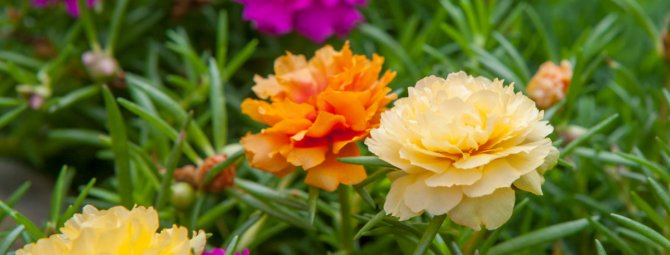
Purslane is a light-loving flower usually grown in annual culture. The best landing site is open, warm and sunny. This low plant, so beloved by both landscape designers and summer residents, will create a blooming carpet on the ground with proper care. It can bloom from June to the very frost. This succulent is grown on flower beds, borders, southern balconies and alpine slopes, and, of course, on windows in the summer season.
Features of growing in balcony pots and in the open field
Purslane came to Europe, and then to Russia from the countries of South and North America. In warmer climates, with mild winters, purslane often becomes a weed, multiplying by self-seeding. The name purslane comes from the Latin portula - which means "collar". This is due to the fact that the seed capsule opens exactly like this: with the gate leaves, only very small.

A box with purslane seeds opens up like a collar, which gave the plant its name
The people call the purslane a rug, because it really rarely grows above 15 centimeters in height, preferring to creep along the surface of the earth. In a room, purslane grows well only in very bright light, preferring southern windows and direct sunlight. It can grow in a room in winter, but with a lack of light it stretches and does not bloom, therefore it is necessary to use additional lighting, best of all with special phytolamps.
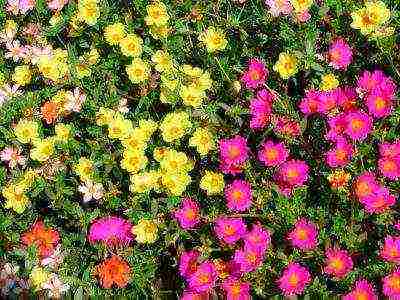
Purslane is often called a rug for its ability to creep thickly on the ground.
It is an annual plant with a fusiform and branched root. The stem is brown, branched, fleshy. The leaves are small, shaped like an oblate egg, fleshy. Blooms in June with small flowers appearing in the branches of the stem. Each flower is kept open for only 1 day, then dies off.
Garden purslane is eaten as a side dish for meat and fish dishes, frying or sprinkling young stems with the addition of vegetable oil, garlic, vinegar or fried onions. It is a healthy vegetable that is easy to grow and rich in trace elements.
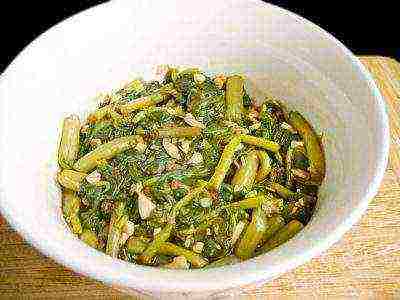
Garden purslane is eaten both raw and stewed or boiled.
But most often, purslane is bred as an ornamental plant. On plots, it is planted on sunny alpine slides, as bright spots in a flower bed.
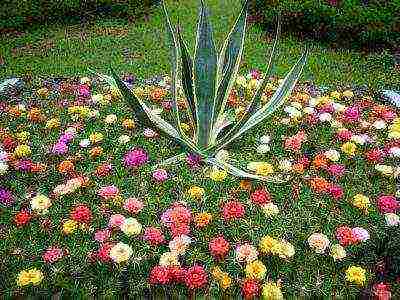
Purslane in a flower bed goes very well with decorative deciduous plants
In apartment buildings, purslane is an excellent solution for hot and southern balconies, where ordinary plants burn out from excess sun and heat. It is better to admire them up close, and thanks to the highly branched stems, it is also planted in hanging baskets.
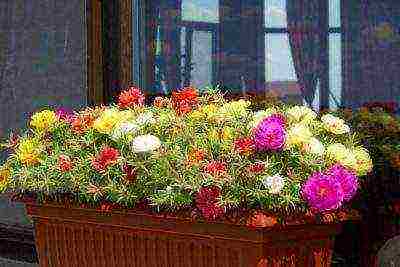
Purslane is often planted in balcony boxes.
Annual or perennial - which is better
In an annual culture, large-flowered purslane is most often grown; it is a decorative flower with a wide variety of shades of flowers. They can be white, red, scarlet, yellow, orange, plain and terry.
There are also perennial varieties of purslane, but in the open field, due to the cold and snowy winter, they can be grown in our conditions only as annuals... Ampel varieties of purslane are most often considered perennials, they can be grown in hanging pots, and in the winter they can be brought into a warm room - an apartment or house, limiting food from September to March and keeping the soil moist. In the spring, such a plant begins to be vigorously fed and cut or simply cut off, stimulating the growth of new shoots or rooting cuttings to obtain new bushes.
In places with warm winters, where the temperature does not drop below +10, the purslane hibernates by itself.
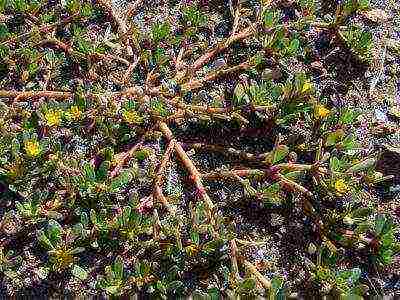
Garden purslane often grows like a weed, but is very useful in the diet.
Garden purslane - stem length up to 60 cm, flowers are small, yellow, of no value. Rich in vitamins A, C, E, PP, contains carbohydrates, proteins, carotene. It quenches thirst well, has a positive effect on mood. For medicinal purposes, it is used to lower cholesterol and blood sugar, with insomnia and liver diseases. Young leaves and shoots are eaten, eating them fresh, boiled or preserving them. Very often it is the vegetable garden purslane that grows like a weed, multiplying by self-sowing.
Airy marshmallows and other varieties of purslane
There is a wide variety of decorative varieties on the market - there are those that require maximum light and those that can bloom in the shade, annual and perennial, with simple flowers and double, and even a mixture of varieties for those who cannot decide. We give a description of the most common varieties, but breeders are constantly developing new ones.
- Long summer is an improved version of terry purslane, characterized by longer and more abundant flowering. Plant height up to 15 cm, blooms only on clear and sunny days, blooming flowers of the most varied colors, reaching a diameter of 5 cm.
- A merry round dance is a terry purslane, whose flowers bloom even on cloudy days. A flower up to 5 cm in diameter, of various colors. Suitable for ampel cultivation, curbs, balcony boxes.
- Coral reef is an annual purslane, up to 15 cm high. The diameter of semi-double flowers is 4 cm, the color is coral. It can grow even on the most scanty and poor soil, on sandy or stony soils with minimal watering.
- F1 cream is an annual purslane variety with cream-colored double flowers. Very beautiful, with strong vigor, grows best on poor and sandy soils. Indispensable in ampelous culture.
- Cherry is a terry purslane that blooms only in sunny weather. Plant height 12 cm, spreads well, flowers up to 5 cm in diameter, cherry color. Very light-requiring, does not bloom even with the slightest shading. Prefers to grow on sandy and dry sandy soils.
- Pink terry - the height of the purslane is up to 10 cm, the stems grow up to 30 cm, branches well, forming a dense rug. Flowers up to 5 cm in diameter, terry. Good for balconies, potting.
- Sunny Princess - a mixture of seeds from the agricultural firm Gavrish - includes double, semi-double and simple varieties of various colors, can grow in a sunny, but damp and cool climate. Grows well on poor and stony soils, even without top dressing. They are planted in flowerpots, on curbs, alpine slides.
- Terry orange - dissolves flowers even in cloudy weather. The plant is short, only 10-15 cm, flowers up to 5 cm in diameter, bright orange. Terry. Resistant to pests and diseases. Can be used for potting, on sunny balconies in boxes.
- Scheherazade is a large-flowered purslane, non-double, with flowers up to 4 cm in diameter. It opens only on sunny days. Blooms in July. Suitable for growing in containers, pots.
- Happy Traels F1 - yellow, orange, pink or red-white striped double flowers, up to 23 cm high, forms a mat up to 45 cm in diameter. It is better to plant on flower beds, slides, in containers.
- Lucky case - large-flowered, two-colored, terry. The color of the petals is white-pink, the stem is light green, up to 25 cm high. It looks very beautiful in balcony boxes, flower beds, flower beds, but it blooms only in sunny weather.
- Pink haze - the flowers are original, double and semi-double, pale pink in color, very much like roses. It grows well in width, forming a spot about 40 cm in diameter. Grows well on sandy, rocky and poor soils with minimal watering. A very good option for ampel landings.
- Tequila Cherry F1 and Tequila White F1 are vigorous hybrids that grow rapidly to form a mat up to 40 cm in diameter. They grow even in humid climates, on the poorest soils with little or no watering. Terry flowers, up to 5 cm.
- Solnechny purslane is an annual plant, up to 10 cm high. Flowers are yellow, up to 4 cm in diameter, open only in sunny weather. Undemanding to the soil. It is advisable to plant on the southern slopes of rocky hills.
- Airy Marshmallow is an annual plant that grows only 10 cm in height and spreads well. Terry flowers of various colors: pink, orange, red, white, lilac, with a diameter of 4 to 6 cm.It can grow on ordinary garden soil, in curb beds, on balconies, in flowerpots.
- Sunglo is a perennial purslane with the largest flowers that do not close even in cloudy weather.
Photo gallery: varieties of flowering purslane
A large selection of varieties allows you to choose exactly the one that the gardener likes, both in terms of flower size and color. Although the decorative purslane loves the sun, there are varieties that bloom in partial shade.
How to propagate purslane
Decorative purslane can be propagated by seeds and cuttings. In regions where winters are warm and summers are long, purslane can give full-fledged seeds and sprout by itself in spring.
Garden purslane multiplies by self-seeding, you can do nothing on purpose.
Reproduction of terry varieties by cuttings
Beautiful hybrid varieties of purslane cannot be propagated by seeds, since they will not pass on the maternal genes, therefore, such purslane is propagated by cuttings:
- A piece of a branch, 10-15 cm long, is cut from the plant.
- Slightly dry the cut and remove the leaves at a distance of 2-3 cm from it.
- The stalk is placed in water or wet sand.
- In dry and hot weather, you can cover the cutting with a transparent bag or spray the cutting with water.
- The rooted plants are placed in a bright place.
Usually, new roots appear after a few weeks. And they are transplanted in several pieces to a permanent place or in seedling pots.
Sowing seeds for seedlings
To get flowering bushes in June and enjoy their beauty longer, the seeds are sown for seedlings in mid-March.... Light and warmth (22 degrees and above) are very important for young plants.
The soil for seedlings is selected light, preferably without the addition of peat, which reduces the germination of seeds. Therefore, it is better to use sod and leafy soil with the addition of ¼ of the washed sand.
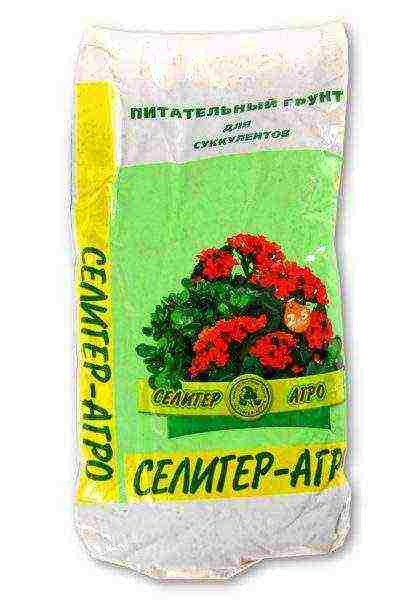
If it is not possible to make your own soil, then buy a ready-made mixture for cacti or succulents
Choose a wide planting container with drainage holes. Small expanded clay or gravel, up to 1 cm high, must be poured onto the bottom of the pot. This is due to the fact that purslane more easily tolerates a lack of moisture than its excess; for proper circulation in the container, there must be good drainage.
The sequence of actions for growing seedlings:
- They fill up the earth in a container and moisten it well with rain or melt water. If there is none, then you can use water that has previously settled.
- Purslane seeds are small, like a poppy seed, they are sown so that the distance between them is 1 cm, slightly pressing into the soil to a depth of 0.5 cm.
- Cover the pot with a film on top and put it in a warm place, with a temperature of at least 22 degrees, but better - 30 degrees. It is desirable that the pot is placed in the light.
- If condensation accumulates on the film, you need to ventilate the greenhouse at least once a day.
- The first shoots of purslane may appear as early as 7 days. Usually purslane rises in unison, it is immediately rearranged on a sunny and warm windowsill, the film is removed.
- Grown up seedlings with 1–2 true leaves dive into individual pots. The earth can be sprinkled up to the cotyledon leaves.
- To grow strong purslane seedlings, you need to provide it with an abundance of sunlight, warmth and moisture, otherwise it stretches out. You can light up the seedlings in the morning, in the evening, and in cloudy weather - all day.
- Well-growing seedlings require feeding at least once a week. At this stage of growth, you can use a universal mineral fertilizer.
Video - how to sow purslane with double flowers for seedlings
Although purslane has good seed availability, there are times when purchased hybrid terry varieties in sachets do not germinate well. In order to preserve the dearly inherited plants, in the future it is better to propagate them by cuttings.
Sowing directly into the ground
In regions with early spring and long summer, you can plant purslane seeds directly into the ground:
- Delicate shoots of purslane can die already with slight frosts, and at +100 air they already stop growing, so you should not rush to planting and be sure to cover them with a film overnight.
- A bed for purslane is dug up, the top layer of earth is mixed with sand and moistened.
- The seeds are mixed with sand and scattered over the soil surface and pressed lightly.
- Water regularly as the soil dries up (on sunny days 1-2 times a week).
- With uneven germination, grown seedlings with 1–2 true leaves are dived and planted. The earth can be sprinkled up to the cotyledon leaves.
- Feed young shoots once a week, after a month - once every 14 days.
Planting seedlings in the ground
The grown seedlings are planted in a permanent place after the threat of recurrent frosts. The air temperature at night should be more than 10 degrees Celsius. In central Russia, this is the end of May and the beginning of June, in more northern regions - after June 12, and in the south of Russia - at the beginning of May.
Necessarily a week before planting in the ground, the seedlings of purslane are hardened and accustomed to the sun. Hardening can be carried out on the balcony if there is no way to take the seedlings to the garden or dacha.
- For the first time, the seedlings are taken out for 15 minutes and placed in a lighted place.
- Then they bring it into the house again.
- Gradually increase the time spent outdoors up to 5-6 hours.
- When planting, the distance between plants should be 15–20 cm. Elongated seedlings can be slightly buried in the ground.
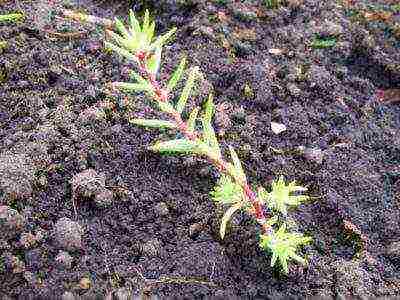
Purslane is planted in the ground with steady heat (soil +10)
A good seedling is a plant with 10 formed leaves and buds.
Where and in what soil is it better to plant a flower
Purslane loves the sun. He is not afraid of even the very hot rays of the southern regions. Where other plants are burned, purslane blooms in bright colors. Therefore, the best place is the southern slope of the alpine hills, along paths, curbs or separate flower beds on the lawn. If you plant a purslane in the shade, then you can not wait for flowers, but the chosen type of flower will also have an effect.
Purslane is undemanding to the ground, on well-fertilized soils it grows quickly and occupies a large surface, but flowering may be weak. For proper maintenance, place it on lighter, sandy or even rocky soils where purslane blooms lush and abundantly..
It is advisable that the purslane is not flooded with rainwater.
Outdoor purslane care
In summer, on hot and sunny days, purslane must be watered, preferably 1-2 times a week with warm water. Purslane is undemanding for feeding, but modern varieties respond very well to mineral fertilizers, which can be applied 2-3 times per summer.

The purslane framing the stones of the path is very beautiful
The first flowers bloom after 6-7 weeks from germination. Each flower lives only 1 day, then it closes and dies off. While the bush is still small, this is noticeable, but when the purslane grows to the state of a dense rug, the flowers bloom constantly in large numbers and it seems that they do not wither at all.
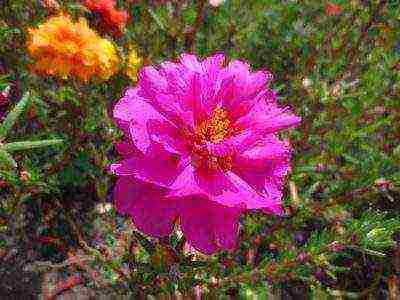
The flower blooms for a day, the bud closes at sunset
How to collect seeds
Since a new bud opens every day, the seeds ripen unevenly. Remove the petals from the pollinated flower and observe the seed pod. About two weeks after pollination, it will turn brown and open, scattering seeds around it. Don't miss this moment if you want to collect them. In autumn, seed ripening takes longer. The collected seeds remain viable for 3 years, but before sowing, their seeds must lie down for at least 3-4 months.
Collected seeds from terry varieties can produce simple flowers next year. That is why it is better to propagate them by cuttings, taking the best plants for the winter.
How can you save purslane in the winter
As a rule, seeds of purslane, especially terry, are not sown in winter.But in the flower beds, where the purslane clearing flaunted in the previous summer, you can find young shoots in the spring. Usually plants with simple (non-double) flowers grow from them.
- At the end of summer, dig up the whole mother plant.
- For the winter, remove to a bright and cool place (temperature about 15-18 degrees).
- Water from time to time, do not feed, which will allow you to preserve and propagate the variety you like in the spring.
- After warming, cuttings of 5–10 cm are cut from it and, having torn off the lower leaves, are planted in boxes or pots for rooting.
How to grow purslane in winter
Due to the snowy and frosty winter, purslane does not hibernate in the open field. Particularly valuable specimens can be dug up and transplanted into a pot, you can collect cuttings from a plant at the end of summer and root them. In winter, such plants are stored in a bright room at a temperature of + 15 ... + 18 degrees, but you can also put them on the southern windowsill, lighting up the purslane in the evenings, then it will continue to bloom until spring, that is, it will grow like a perennial.
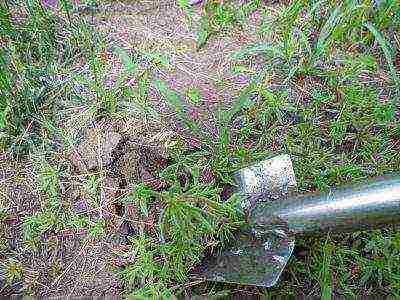
your favorite purslane bushes can be dug up and taken home
Garden purslane reproduces well by self-seeding, so they do not dig a garden bed with it for the winter.
If the purslane does not bloom
The most common reason for the lack of flowering is the wrong choice of planting site, with a lack or lack of sunlight. In this case, the purslane will be frail, the stems are thin, and flowering may not come.
The second reason for the lack of flowering is too fertile land. Purslane grows green mass, it feels good, it fattens and therefore does not give flowers. If you plan to grow the plant there permanently, you can add sand and small pebbles before planting and dig up.
Room purslane (on windows and balconies)
Purslane can be grown not only in the garden, but also in the apartment. Better to choose beautiful terry varieties that bloom even in cloudy weather (Pink Terry, Orange, Sunglo).
Conditions of detention - table
For a pot culture, it is better to grow purslane as a succulent, acquiring the appropriate soil: loose, breathable and without peat. It is imperative to put drainage on the bottom of the pots.
You can grow through seedlings, then transplanting into a small container or pot. Moreover, you can plant several bushes at once, and if you take seeds for sowing not of the same color, but with a mixture, then the home flower bed will be very bright and varied.

Purslane can be grown on a window by planting several plants at once in one pot
It is important to remember that this is a sunny flower and only a southern windowsill or balcony will suit it. If the windows are to other sides of the world, and you want to grow beautiful flowers, be prepared to regularly highlight the purslane and take additional care.
In the summer months, the purslane can be fed once a month for lush flowering, by the fall, the feeding is removed, long stems can be cut off, and the pot can be rearranged to a cooler place.
In the spring, the bush wakes up and blooms with renewed vigor.
Florist reviews
Purslane is an excellent plant for sunny places: windows, balconies, flower beds, alpine slides. It is short and will not obstruct other plants. It is valued for its bright flowers and dense growth, due to its unpretentiousness, it is easy to care for it and get seeds, so that next year your plot or balcony looks just as great.
Hello, my name is Irina, I am 33 years old. I love my collection of hippeastrum very much, but I do not offend other flowers either. Rate the article:
(1 vote, average: 5 out of 5)
Purslane
Purslane belongs to the purslane family. More than 100 species of purslane are known, which grows mainly in the tropics and subtropics. This plant is native to the southern regions. Since ancient times it has been known in Egypt, Greece, Rome. Europe was mastered by the plant rather late.Around the 17th century, it somehow made it to France and conquered it as a vegetable crop.
Purslane herb contains a lot of sugars: glucose, sucrose, galactose, other carbohydrates, a significant amount of vitamins C and K; found in it carotene, vitamins E, PP, organic acids (succinic, citric, malonic), proteins, mineral and other valuable substances.
Large-flowered purslane is an ornamental plant with bright flowers that open on a sunny day, used as a vegetable. Purslane has edible leaves and stems.
In home cooking, finely chopped purslane leaves are used with cottage cheese, tomatoes; they are used to prepare a salad with the addition of olive oil and vinegar, hot seasonings for meat dishes, add to soups and vegetable dishes, salt and pickle.
In folk medicine, purslane is used as an anti-inflammatory agent for diseases of the kidneys, liver and bladder. The juice of the aerial part of the purslane has a choleretic effect. Seeds have especially valuable medicinal properties: in case of indigestion - as an astringent, in case of fever - as an antipyretic; they are part of the folk remedies for impotence. There are known cases of curing scaly lichen by decoction of seeds. In the Caucasus, fresh leaves of the plant relieve inflammation from a bee sting. In recent years, scientists have paid attention to the ability of this plant to lower blood sugar levels.
Large-flowered purslane is used in ornamental gardening. It is an annual herb with creeping stems. The leaves are small, alternate, juicy. The flowers are also small, yellow and open only in sunny weather, blooming from June to September. Seeds are black, rarely dark gray, small. Collect the shoots of purslane in the budding phase, cutting them off at the base of the stem. Shoots usually grow 8-10 times a year.
Cultural forms of purslane differ from the wild one in larger leaves and raised shoots.
Growing purslane at home
Purslane is placed in rooms in a bright place, but it can grow in partial shade. The plant is thermophilic, it should be warm all the time.
Purslane is propagated by both seeds and cuttings. For cuttings use the tops of the shoots with 2-3 internodes. It takes root easily. In order to avoid decay, the cutting is sealed to a depth of no more than 2-3 cm.
The best substrate for sowing seeds is a soil consisting of turf, leafy soil and coarse sand in a ratio of 5: 4: 1. To disinfect the substrate, we recommend adding 100-200 g of wood ash to one bucket of substrate. Seeds are sown in pots or small boxes 12-15 cm high. The poured substrate is slightly moistened and rolled, the seeds are sown randomly, moistened with a spray bottle and the box is closed with glass.
Seedlings appear 3-4 days after sowing. Watering is moderate. Top dressing with liquid mineral fertilizer is carried out once every 2-3 weeks. It is necessary to leave a distance of 7 cm between the plants, 10 cm between the rows.
Pests - whitefly, rarely aphids. Of the diseases, purslane is harmed by various spots, and on seedlings, with insufficient care, a black leg.
Next chapter>


